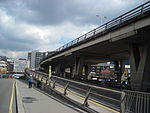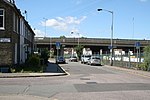Duppas Hill
1707 establishments in EnglandAreas of LondonCricket grounds in SurreyCricket in SurreyDefunct cricket grounds in England ... and 9 more
Districts of the London Borough of CroydonEnglish cricket venues in the 18th centuryHistory of SurreyParks and open spaces in the London Borough of CroydonPoor law infirmariesSport in the London Borough of CroydonSports venues completed in 1707Sports venues in SurreyUse British English from August 2015

Duppas Hill (or Duppa's Hill) is a park, road and surrounding residential area in Waddon, near Croydon in Greater London (and historically in Surrey). Duppas Hill has a long history of sport and recreation. It is said that jousting took place there in medieval times and the story goes that Lord William de Warenne was treacherously slain there during a joust in 1286.
Excerpt from the Wikipedia article Duppas Hill (License: CC BY-SA 3.0, Authors, Images).Duppas Hill
Duppas Hill Road, London Waddon (London Borough of Croydon)
Geographical coordinates (GPS) Address Nearby Places Show on map
Geographical coordinates (GPS)
| Latitude | Longitude |
|---|---|
| N 51.367222222222 ° | E -0.10972222222222 ° |
Address
Duppas Hill Road
CR0 4BG London, Waddon (London Borough of Croydon)
England, United Kingdom
Open on Google Maps










